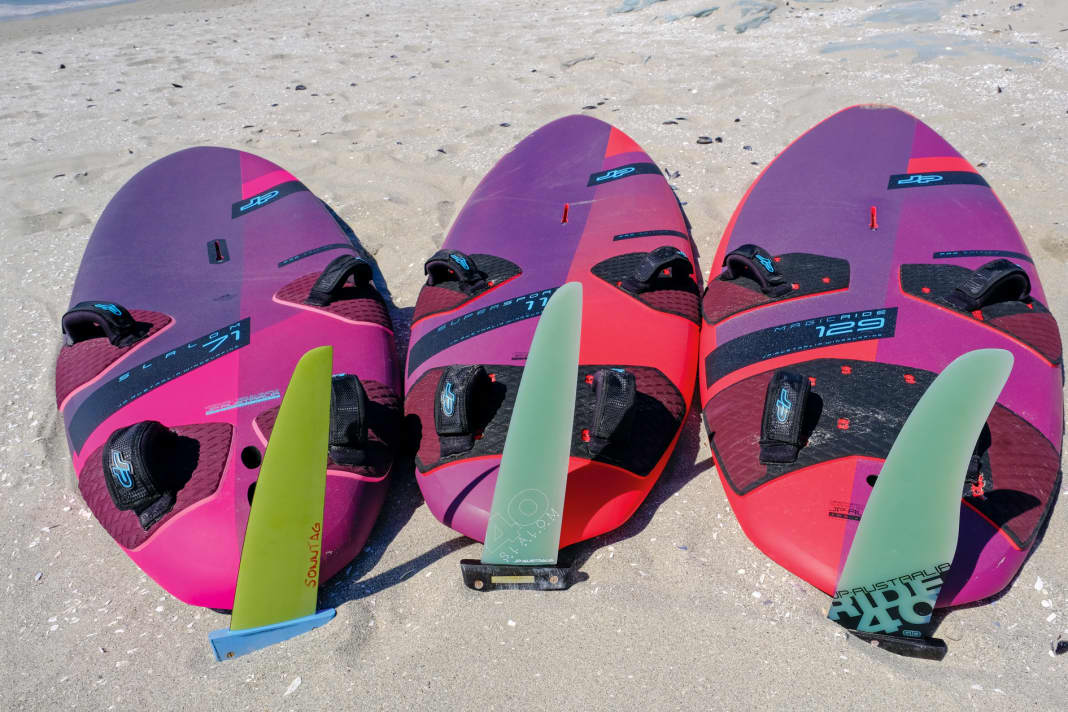





"Wow, that's a lot of tucked! And look here, the cut-outs are pretty pronounced too! I wonder if that's compatible with so much "V"?" Where insiders can lose themselves in shape details, amateur surfers stand next to it and see: Nothing! Just a surfboard. But even recreational surfers quickly realise that board A rides differently to board B. But which subtleties ultimately ensure that you don't want to get off some boards, but don't want to have others - at first glance very similar shapes - for free?
Using JP-Australia as an example, we compared boards for freeride newcomers, sporty heaters, freeracers and slalom pilots in terms of their subtle differences, explained the most important terms and interviewed Werner Gnigler, an experienced shaper, about the background.
In this article:
Outline
What the term means: The term "outline" refers to the outer shape of a board.
What differences you can see: Freeride boards aimed at hobby surfers, such as a JP Magic Ride, are generally longer and often rounder, i.e. more "egg-shaped" (picture below, right), than sportier models. For example, a 119 Magic Ride is almost ten centimetres longer than the Super Sport or Slalom models, which are aimed at experienced racers.
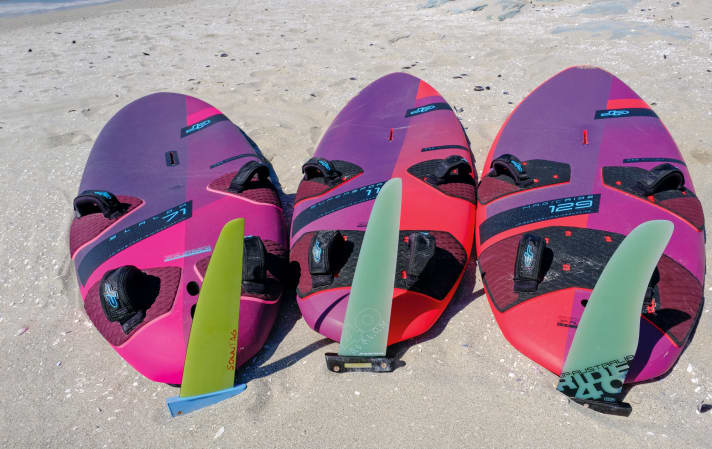
What the shaper says: "Freeride boards like the Magic Ride are optimised for easy planing, among other things. More length helps with this, which makes the board less susceptible to incorrect loading and guarantees a harmonious transition from bobbing to gliding. Volume distribution is also crucial. Boards such as Magic Ride or the somewhat sportier Super Ride have an even volume distribution from front to back, with sufficient volume in the bow. This makes tacking and planing easier. On boards in the Freerace and Slalom classes, the nose areas are increasingly thinned out and the volume is concentrated in the tail (picture below). This improves control at top speed, but you also have to be more sensitive when planing and tacking to prevent the bow from diving.
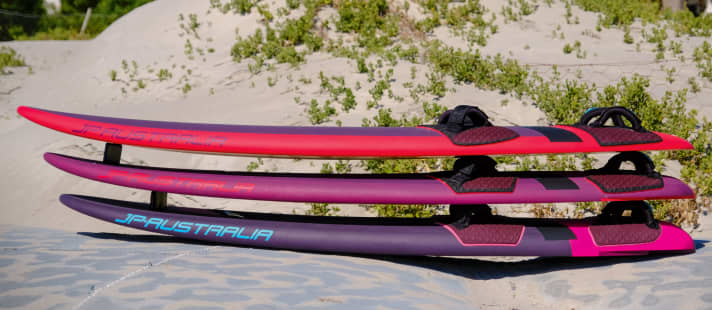
However, because boards for freeriders should also go effortlessly into the jibe, their tail areas are usually kept narrow. In combination with a generous width in the centre area, this results in the aforementioned "egg-shaped" outline. With freerace boards and slalom shapes, however, there is no getting around wide tails. Maximum top speed in race mode can only be achieved if you can ride a large sail and control the power. Large sails require long, powerful fins, which in turn require a corresponding lever on deck and a pilot who can counteract with strength and skill. This means that on boards like Super Sport and Slalom, you have to stand further away from the centre of the board - on a wide tail and in straps mounted far out."
Cutouts
What the term means: "Cutouts" are recessed areas in the underwater hull of the board with the aim of reducing the surface area.
What differences you can see: While the freeride boards of many brands still manage completely without cutouts, these are becoming increasingly larger and more striking as the boards become more performance-orientated. A marketing gag? Or a design highlight?
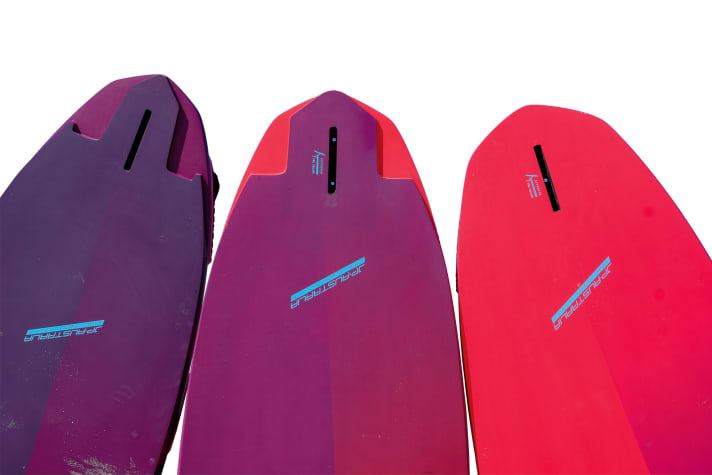
What the shaper says: "As already mentioned, performance-optimised boards need a wide tail, but this also means they have a large "wetted surface" - i.e. a surface that is constantly in contact with the water and thus generates friction. By reducing the surface area in the underwater hull, friction is also reduced, which benefits the top speed, and the board also appears freer and flies more controlled over the chop. In concrete terms, this means that the rider does not have to push with as much leg power to make the board fly freely over the chop.
The bottom line is that cutouts allow you to combine two isolated outlines: A wide deck at the top, which provides appropriate leverage, and a narrower outline in the underwater hull, which allows the board to fly freely and reduces the pressure on the legs. The shape of the cutouts allows you to control exactly where the water breaks off the board and achieve an even distribution of pressure on the legs. As freeride boards (pictured above, right) are optimised for planing and the normal wind range, they get by with narrower tails and smaller fins, which automatically results in less pressure on the legs. Cutouts are therefore not absolutely necessary."
Rails
What the term means: "Rails" is the English term for the edges of a board.
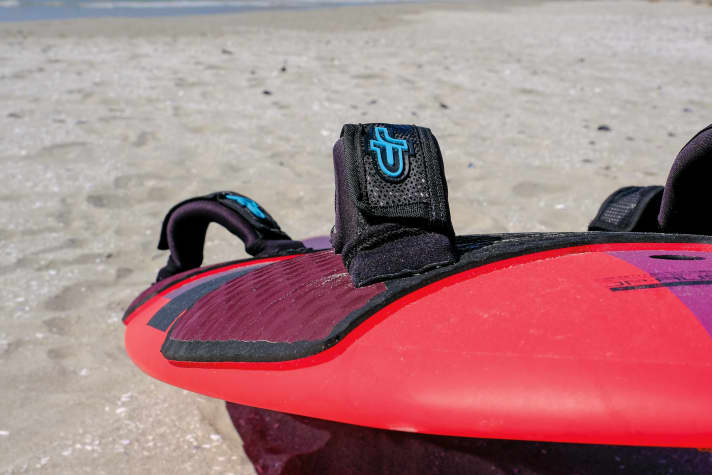
What differences you can see: Typical freeriders for the masses (e.g. Magic Ride or Super Ride) have quite thin edges (picture above), the more sporty the board becomes, the thicker and more voluminous the rails become - they are thickest on the slalom board (picture below). But why?
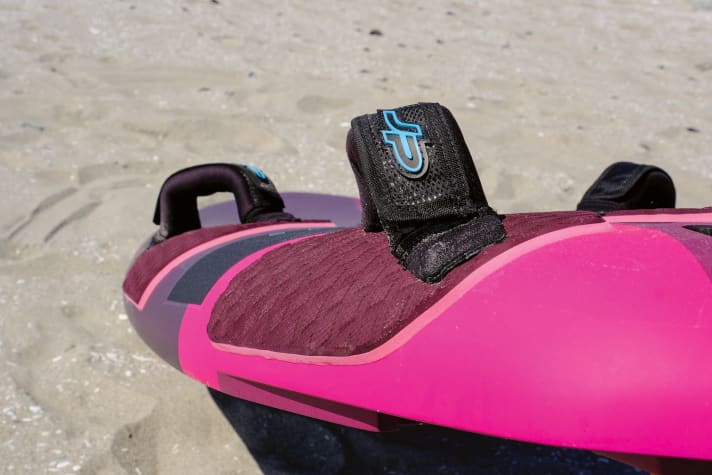
What the shaper says: "Here, too, it's all about getting the sail power onto the water in a controlled manner. If you want to glide back and forth comfortably and use a normal camberless sail, you want to be comfortable in all positions. For this reason, we design the edges of freeride boards to be thin and the board to be thicker in the centre, resulting in a rounded deck on which you can still stand comfortably even with straps mounted on the inside. Thin edges are also easy to push into the water when jibing, even with less power and technique.
Conversely, with performance-optimised shapes: our Super Sport freerace board and the Slalom have noticeably thicker edges. The raised standing position means you can simply apply more power to the rail and keep the boards on the water for longer at the limit. Thick edges also offer more lift at the exit of the jibe and therefore better acceleration at the jibe buoy. The area around the mast track is often lowered on freerace and slalom boards, which also helps with control. However, thick, high rails and a thin centre area ensure that you can only stand directly on the edge on a comfortable curve, according to Adam Riese; a loop position further inwards would be completely uncomfortable because you would be standing 'downhill' and with overstretched ankles. That's why these types of boards are not even equipped with climber-friendly strap positions."
"V" & "Concave"
What the term means: "V" and "concaves" are typical design features for the underwater hull of windsurfing boards. "V" indicates an implied keel, i.e. the centreline of the board is lower in the water than the edges. Conversely, if the edges are lower in the water than the centre line of the board, the underwater hull would have a concave shape. In the freeride and race sector, a "double concave V" is one of the standard elements of the shaper guild.
What differences you can see: Freeride boards are traditionally given more "V" than performance-orientated shapes in the freerace or slalom categories - in other words, they are more angled.
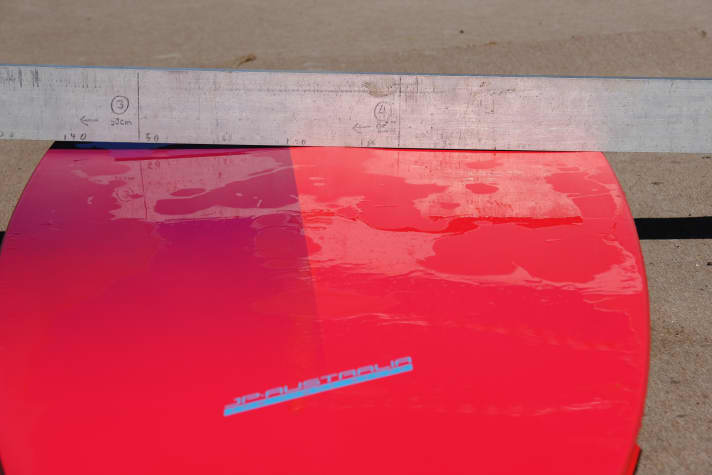
What the shaper says: "We shapers use the "V" to regulate the ride comfort. To put it simply, boards with a larger "V" are softer in the chop, as the indicated keel cuts into the chop. If you combine the "V" with small double concaves, the dampening effect is further enhanced - which is why most boards have a double concave V in the underwater hull. Board types that are primarily designed for comfort are therefore equipped with more "V". In our range, the boards from the slalom board to the sporty Freeracer Super Sport and the freeriders Super Ride and Magic Ride are gradually getting more and more "V" with double concaves. However, the "V" is not equally pronounced on all boards, it depends on where the V is located in the underwater hull: at the front, in the area of the mast track, there is often more "V", the board then cuts in more comfortably in the chop. At the same time, the edges sit a little higher above the water and don't get caught in the chop so quickly. In the stance area, the "V" is often reduced so that the loss of performance is not too great, as too much "V" would make any board sticky. For this reason, freerace or slalom boards (picture below) have less "V", simply because the focus is on a sporty riding experience and maximum performance."
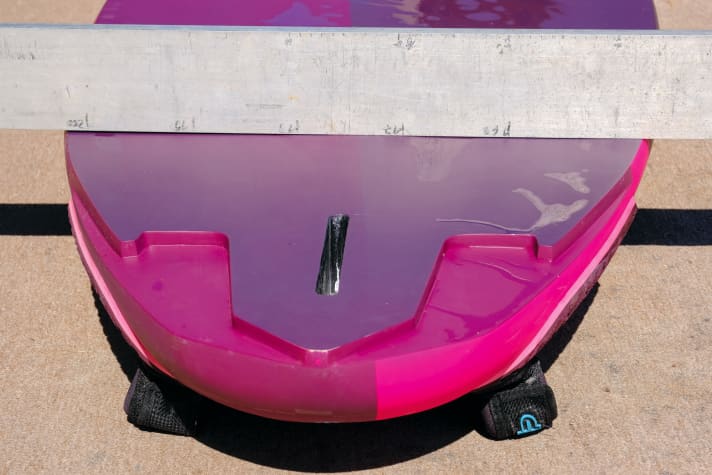
Scoop-Rocker line
What the term means: The scoop-rocker line describes the bend of the underwater hull. Bending up in the bow area is commonly referred to as "scoop", whereas in the stern area it is called "rocker". If a board has a visible curve behind the fin, this is referred to as a "tail kick".
What differences you can see: "Rockered" boards, which reveal a lot of rocker line, are generally considered to be lazy and easy to turn, while a flat scoop rocker line is usually associated with good gliding performance and poor turning properties. In this respect, it is quite surprising that the measuring stick placed along the centre line of the board reveals very little difference between different board classes such as freeride, freerace or slalom. So is the influence of the rocker line on riding characteristics generally overestimated?
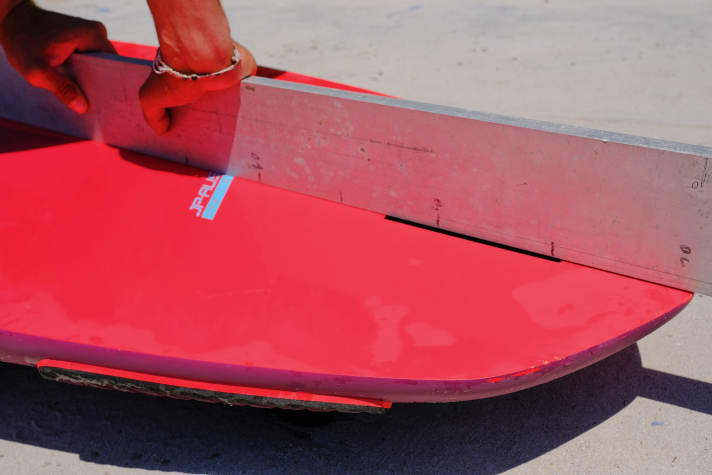
What the shaper says: "If you only look at the rocker line, most freeride boards from different manufacturers are very similar and flat these days (picture above), simply because good planing is important to all windsurfers. I control the manoeuvring characteristics mainly via the V-curve. The Freerider Magic Ride, for example, has a lot of V at the front, less V in the centre and more V at the back. This gives the board a stronger rocker line in the edge area than in the centre. When edged in the jibe, I surf around the corner on a round rocker line, when ridden flat, the board offers a lot of performance when planing, because the straight rocker line in the centre area is then more decisive. Simply placing a yardstick on the centre line says little about the actual rocker line and the expected manoeuvring characteristics."

